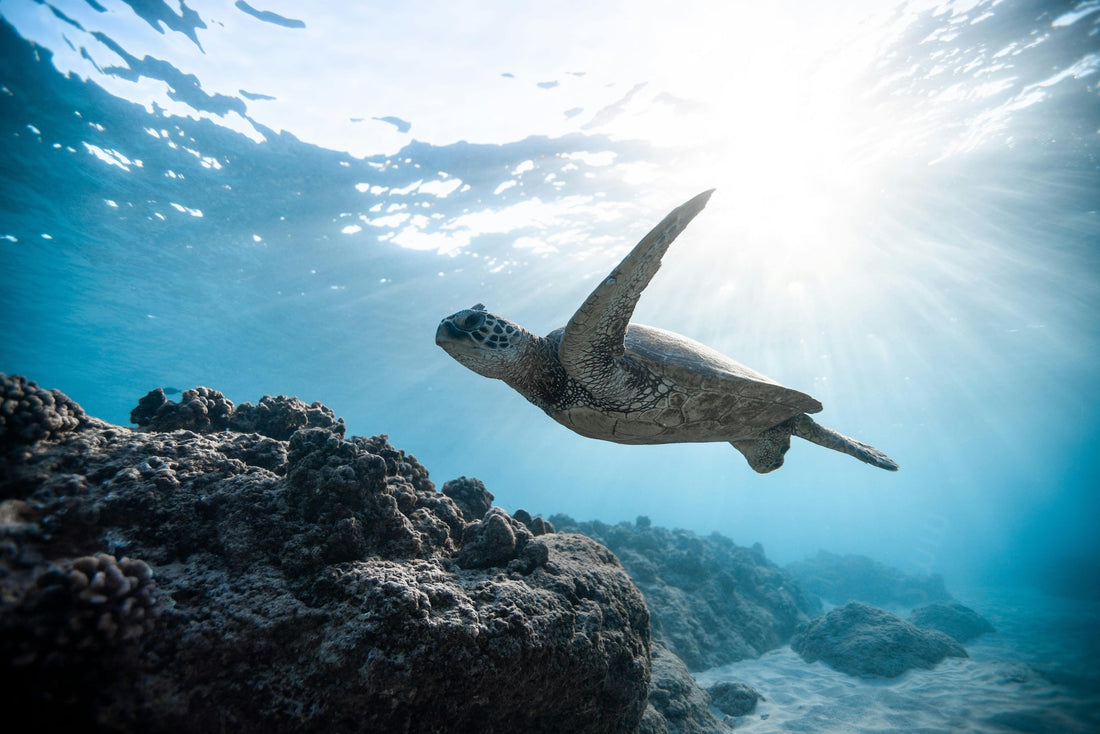The Florida Keys are a dream destination for divers and snorkelers. This island chain is home to the only living coral barrier reef in the continental United States, protected within the boundaries of the Florida Keys National Marine Sanctuary. Stretching 2,896 square nautical miles, this sanctuary is a hotspot for biodiversity, including coral gardens, seagrass meadows, and wreck dives.
What makes diving here so unique is its accessibility. Whether you’re heading out on a snorkeling tour in Key Largo or gearing up for a drift dive at Molasses Reef, the Keys offer something for every skill level. Boat charters and beginner-friendly sites, such as Christ of the Abyss, make underwater exploration easy and unforgettable. Here’s a look at some of the iconic marine life you might encounter along the way.
Sea Turtles

Three types of sea turtles frequently grace the waters of the Florida Keys: Green, Loggerhead, and the smaller, beautifully patterned Hawksbill. These gentle cruisers are often seen grazing on seagrass beds or gliding near reefs like Looe Key and Sombrero Reef.
The best time to spot them is May through October, which is peak nesting season, but turtles are present year-round. All sea turtles are protected under the Endangered Species Act. Seeing one is not only a thrill, but also a reminder of why conservation efforts matter.
Nurse Sharks & Reef Sharks

Let’s talk sharks. Because yes, they’re here, and no, they’re not out to get you.
Nurse sharks are the laid-back loungers of the reef world, often spotted resting under coral ledges. Caribbean reef sharks, while a bit more active, are typically shy and uninterested in divers. Both play a critical role in reef health by keeping fish populations in check.
Diving spots like Molasses Reef and Dry Tortugas often provide sightings, especially if you’re patient and observant.
Spotted Eagle Rays & Southern Stingrays

Few sights are as awe-inspiring as a spotted eagle ray soaring past you like an underwater bird. Their spotted wingspan can reach up to 10 feet, and they’re often found in deeper reef channels or sandy flats. Southern stingrays tend to favor shallow, sandy areas, where they often bury themselves just beneath the surface. Watch the seafloor closely. Those subtle ripples might be a ray hiding in plain sight.
Colorful Reef Fish

The Florida Keys are home to hundreds of vibrant fish species, including:
-
Parrotfish (reef cleaners and algae munchers)
-
Angelfish (large, colorful, and easy to spot)
-
Sergeant majors (those bold little guys that swarm around snorkelers)
-
Butterflyfish (tiny and elegant with bold markings)
It’s like swimming through a living kaleidoscope. Not only do they bring the reef to life, but many also play vital roles in reef maintenance and coral health. Reef fish can be found all over the Florida Keys.
Corals & Sponges

You can’t talk about marine life without mentioning the reef itself. Brain corals, elkhorn coral, vibrant sea fans, and towering barrel sponges bring the reef to life with texture and color. Sites like Dry Tortugas and Molasses Reef offer an up-close look at some of the most striking underwater landscapes in the Keys. Unfortunately, coral bleaching and disease have taken a toll, which is why organizations like Reef Relief are working hard to restore and protect them.
Groupers & Barracudas

Groupers, the big boys of the reef, can grow to impressive sizes and are often spotted lurking near rocky outcroppings or artificial reefs. Barracudas, with their sleek, toothy grin, are more curious than dangerous, often hovering nearby and watching you with interest. Respect their space, move slowly, and enjoy the show.
Manatees

While not typically reef dwellers, manatees are often spotted in the Florida Keys’ inshore waters, especially near marinas or mangrove channels. These gentle giants are herbivores and pose zero threat, but they are vulnerable to boat strikes and pollution. If you're lucky enough to see one, give them plenty of space and never feed or touch them.
Wild Cards

While most encounters in the Keys involve reef residents, there’s always the chance for something unexpected. Lucky divers may spot sawfish, hammerheads, tiger sharks, or even a whale shark during seasonal migrations. These sightings are rare, but part of what makes diving here so thrilling is never knowing what might glide out of the blue.
Final Tips for Your Florida Keys Dive Adventure
-
Book tours early during high season (December–April), especially around the holidays.
-
Support eco-conscious operators who follow reef-safe practices.
-
Invest in reef-safe sunscreen and UV-protective gear.
-
Leave only bubbles. Respect the reef and its residents.
At Grateful Diver, our gear is designed for salty adventures like this, offering sun protection, quick-dry comfort, and a style that celebrates the sea. Plus, a portion of every purchase goes to Reef Relief's efforts to save and protect the reef. See you on the water!

